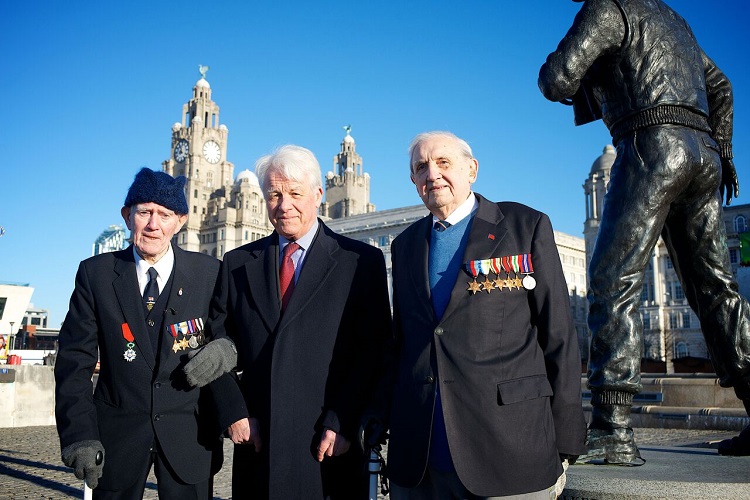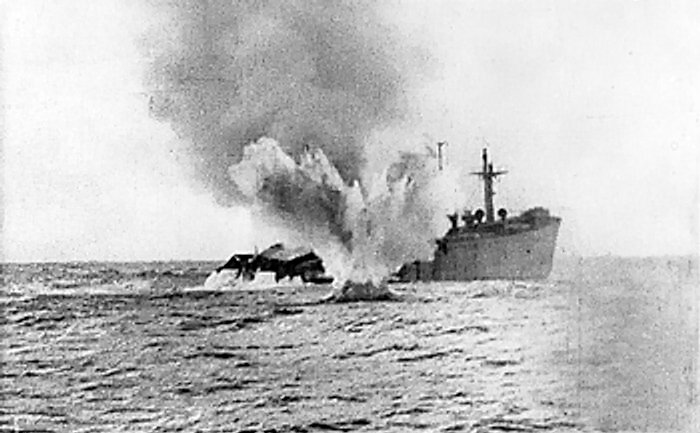Battle of the Atlantic Memorial Campaign to Tour America
The charity that has launched a campaign to build a £2.5 million ($3.5 million) memorial to the Battle of the Atlantic on Liverpool’s waterfront is planning an awareness raising tour of the U.S. after receiving the backing of the British Ambassador to the U.S. Sir Kim Darroch.
The U.S. played a critical role in winning the battle with the production of Liberty merchant ships and the operations of the U.S. Navy and its Hunter Killer Task Groups.
Events are planned for the British Embassy in Washington as well as consulates including Chicago, New York, Boston and Atlanta. The campaign also plans to engage with the U.S Navy and U.S. Coast Guard.
The Battle of the Atlantic Memorial (BOAM) chairman Vice-Admiral Mike Gretton, whose father Vice-Admiral Sir Peter Gretton served during the battle as an Atlantic Escort Group commander, said he hopes the American tour will see long term cooperation built with American institutions including the U.S. Navy, the World War Two memorial in Washington and the Battle of the Atlantic exhibition at the Science and Industry museum in Chicago.

Left to right: veteran Jim Rainsford, Vice Admiral Mike Gretton campaign chairman, veteran Graeme Cubbin
The Memorial

Despite the immense significance of the Battle of the Atlantic and the 100,000 lives lost, it does not have a dedicated national memorial in Britain.
The BOAM has unveiled a design by acclaimed sculptor Paul Day for a 28 meter, 15 ton monument in the shape of a merchant ship split in two. The memorial will incorporate the existing statue of U-Boat hunter Johnnie Walker. Paul Day’s works also include the Battle of Britain Monument and the Iraq-Afghanistan memorial, both in London.
The memorial will also be sited on National Museums Liverpool’s land, between the River Mersey and the Museum of Liverpool. The campaign is aiming to unveil the monument in 2019, the 80th Anniversary of the start of the battle and the beginning of World War II.
The memorial will reflect the international nature of the battle recognizing the efforts of British and Allied Merchant Navies and Armed Forces including the U.S., Canada, Norway, the Netherlands, Belgium, France, Poland, Brazil, Australia, New Zealand and Russia. In addition, the monument will also commemorate the thousands of seafarers from around the world who served in Allied Armed Forces and Merchant Navies including India and China.
The Battle of the Atlantic

The name "Battle of the Atlantic" was coined by Winston Churchill in February 1941. Describing the battle, Churchill said: “The Battle of the Atlantic was the dominating factor all through the war. Never for one moment could we forget that everything happening elsewhere, on land at sea or in the air, depended ultimately on its outcome.”
The Battle of the Atlantic was the longest campaign of World War II. It began on September 3, 1939 and lasted until VE Day, May 8, 1945, in total five years eight months and five days. Its core was the Allied naval blockade of Germany, announced the day after the declaration of war, and Germany's subsequent counter-blockade. It was at its height from mid-1940 through to the end of 1943. The Battle of the Atlantic pitted U-boats and other warships of the Kriegsmarine (German navy) and aircraft of the Luftwaffe (German air force) against the Royal Navy, Royal Canadian Navy, U.S. Navy and Allied merchant shipping.
The convoys, coming mainly from North America and predominantly going to the United Kingdom and the Soviet Union, were protected for the most part by the British and Canadian navies and air forces. These forces were aided by ships and aircraft of the United States beginning September 13, 1941. The Germans were joined by submarines of the Italian Royal Navy (Regia Marina) after their Axis ally Italy entered the war on June 10, 1940.
The cost of the battle was extremely high for both sides. It is impossible to be sure how many died but an estimated 26,500 British merchant seamen were killed while the Royal Navy lost more than 23,000 seamen. The allied war dead of naval and merchant seaman is estimated at more than 20,000 from Canada, U.S., India, China, Poland, Norway, Holland, Greece, Belgium, South Africa, Australia, New Zealand and Russia. In total around 3,500 merchant ships were sunk and 15 million tons of allied shipping was lost.
Many thousands of civilians were also caught in bombing raids at ports and shipyards on both sides of the Atlantic. In Liverpool, for example, the ‘May blitz’ of 1941 saw 1,746 Merseysiders killed and 1,154 injured in eight nights of bombing. Meanwhile, the U-Boat memorial near Kiel has the names of 28,000 crewmen who died, more than 60 percent of those who served. Of the 859 U-boats 648 were lost, across all seas in which U-Boats operated.
Getting Involved
The BOAM campaign is also engaging with all other allied nations who took part in the Battle of the Atlantic to involve them in the memorial.
For more information on the campaign, sponsorship packages and to make donations visit: www.battleoftheatlantic.org email: [email protected] call: 01243 545939 Twitter: @BattleAtlantic
